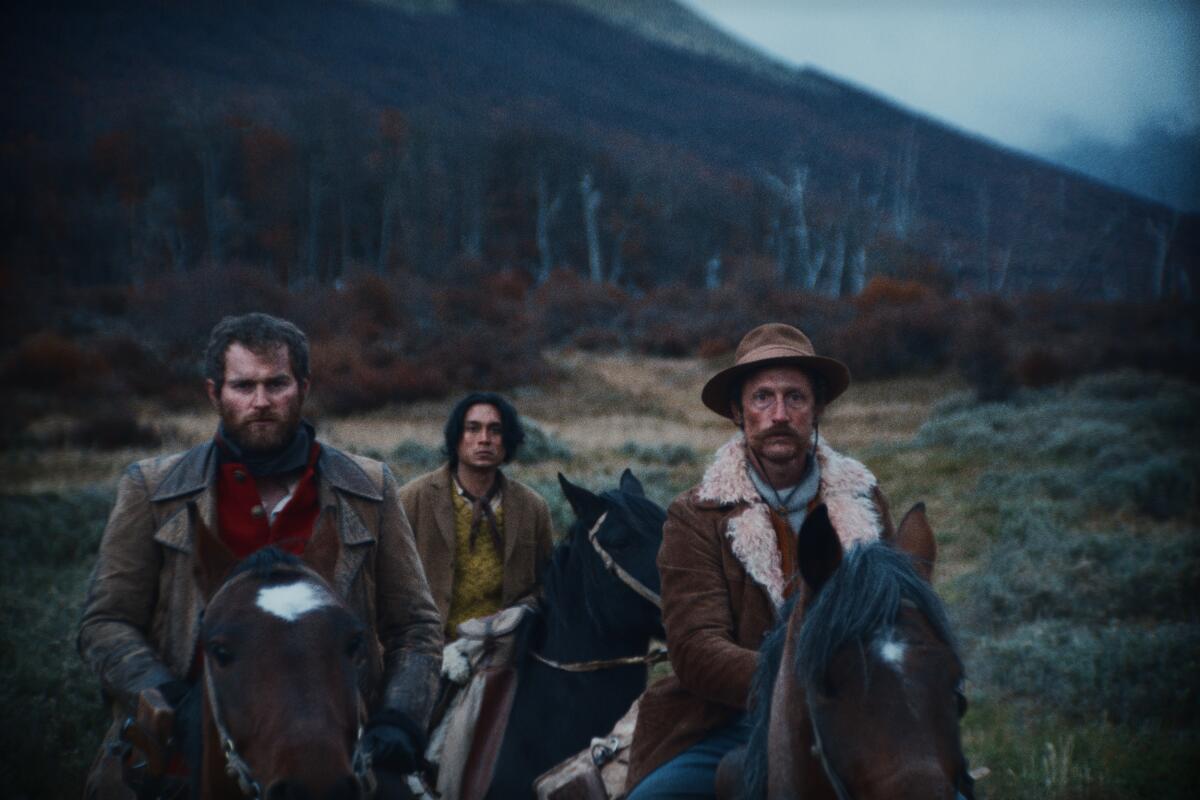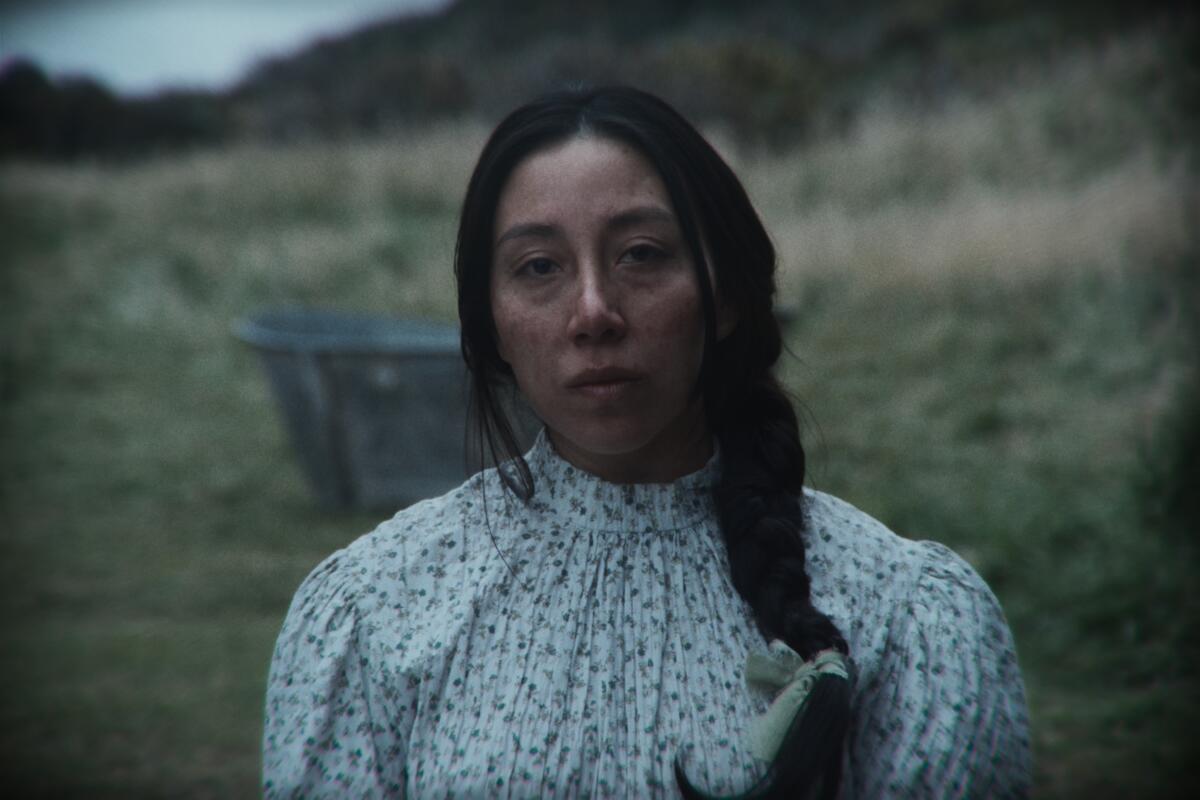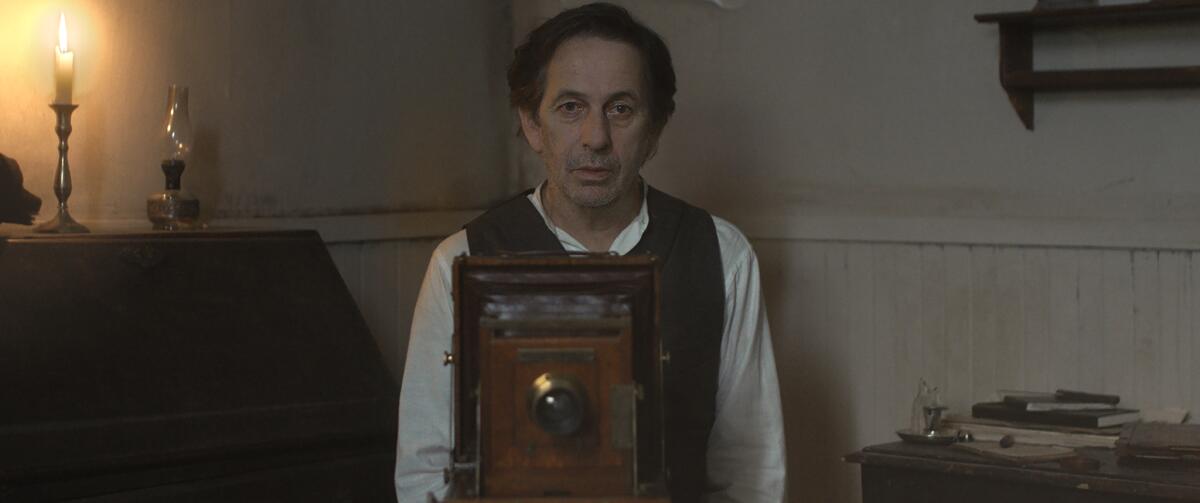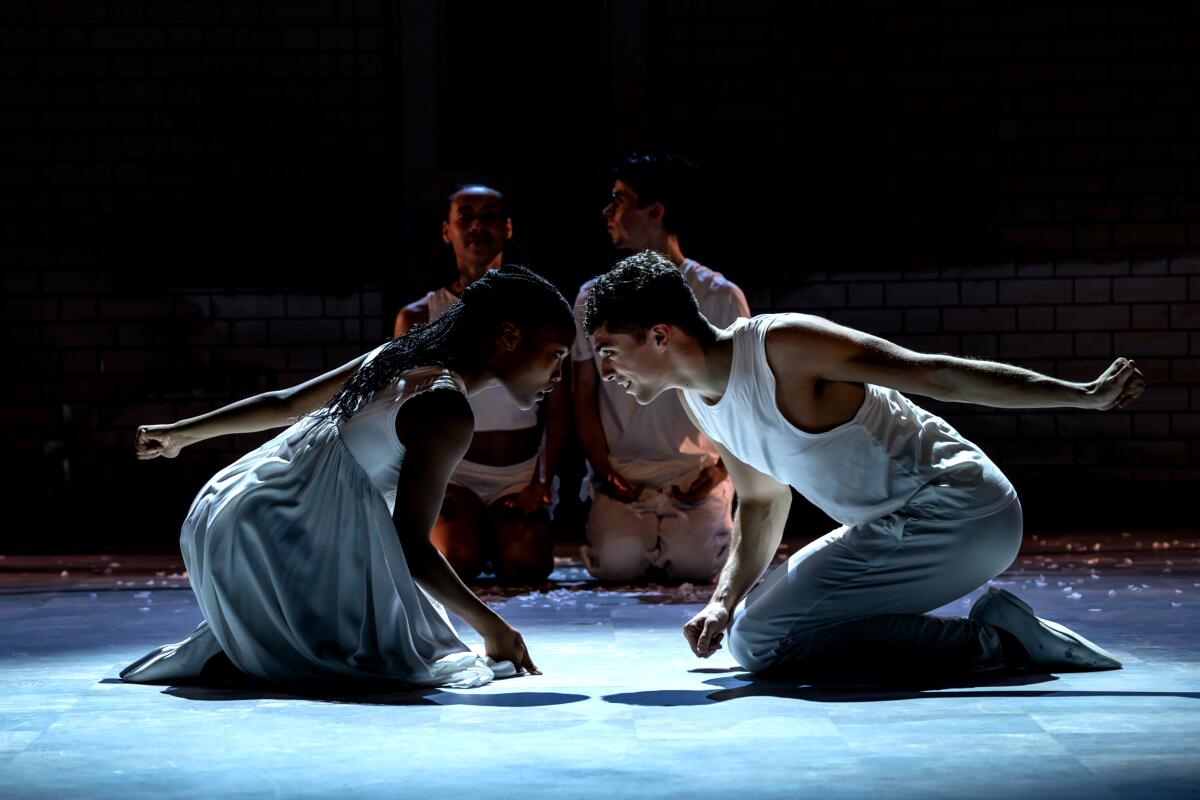Two Chilean films depict Tierra del Fuego’s brutal colonization — and with it, art’s role

It’s been a devastating week at the Los Angeles Times, with the layoffs of countless colleagues. That is going to mean some changes around here. I’m Carolina A. Miranda, art and design columnist, and I’ll continue to keep you posted on all that — as well as the latest essential arts news:
The purges of Patagonia
For the last couple of months I’ve been working my way through Oscar contenders, and last night I managed to catch the final screening of Chilean director Felipe Gálvez’s “Los Colonos” (“The Settlers”) at the American Cinematheque. The film is a western that is also an anti-western, recounting the genocidal settlement of Tierra del Fuego by European and criollo ranching families who hired mercenaries to systematically kill Indigenous Selk’nam people to seize their land.
In its first half, the film largely follows a gritty trio as they descend into this heart of darkness: a Scottish mercenary named Alexander MacLennan (played by Mark Stanley), a U.S. cowboy named Bill (Benjamin Westfall) and Segundo (Camilo Arancibia), a mestizo sharpshooter, who, for obvious reasons, is conflicted about the assignment at hand. In the second half, we spend more time with the voracious landowner for whom they labor, José Menéndez (the always impeccable Chilean actor Alfredo Castro), who sees his task as one of “civilizing” the untamed. The character is based on a historical figure of the same name who was renowned for his murderous conquests.

As a film, “The Settlers” is a bit of a blunt instrument. The horrors are bounteous, the narrative a bit disjointed; the Indigenous people, along with Segundo, who is half Mapuche, say little or are largely silent. To some degree, this is intentional. As Gálvez told De Los contributor Carlos Aguilar, “I didn’t try to make a film to speak for Indigenous people but rather to take a critical stance about the colonization process from the point of view of the white world or the world of mixed-race people, to talk about how history is written, how it can be rewritten and what role cinema occupies.”
He isn’t the first filmmaker to engage the fraught subject of the Selk’nam genocide. The 2019 movie “Blanco en Blanco” (“White on White”), directed by Spanish-Chilean filmmaker Théo Court, likewise recounts this barbarous history — albeit with a bit more grace. (Like “The Settlers,” it too served as Chile’s submission to the Academy Awards for international feature film, though neither made the shortlist.)
In “White on White,” the narrative — structured like a thriller — centers on Pedro, a photographer who lands in Tierra del Fuego with the intention of shooting a wedding for a wealthy, mysterious landowner; he slowly and terrifyingly comes to the realization that he’ll be recording a genocide instead. Pedro (Castro, in a searing performance) makes the unexpected journey from innocence to barbarity.

Both films take advantage of the austere Patagonian landscape and its penetrating gloom to build on the terror. (The region seems to loom large in Chilean film of late: Pablo Larraín’s “El Conde,” which imagined former Chilean dictator Augusto Pinochet as a bloodsucking vampire — and was nominated for an Oscar for its remarkable cinematography — was set in this remote territory as well.)
Both films also dwell on the role of art in supporting sadistic colonial enterprise, as noted above by Gálvez. In “The Settlers,” literal film becomes a tool by which to subjugate; in “White on White,” photography serves as a way of creating a triumphal (if grotesque) record of subjugation. As Zimbabwean novelist Yvonne Vera has written: “The camera has often been a dire instrument. In Africa, as in most parts of the dispossessed world, the camera arrives as part of the colonial paraphernalia, together with the gun and the Bible.”
The major unnamed character in both movies is the camera, which offers an intriguing meta narrative about the role the gaze can play. The historical story lines are bracing, but the subtext — about who authors history and how — is what ultimately makes these two pictures worthwhile.
“The Settlers” will stream on Mubi after the conclusion of its theatrical release; find “White on White” on Amazon or Apple TV.
You’re reading Essential Arts
Make the most of L.A. with our guide to events and happenings in the SoCal arts scene. In your inbox once a week.
You may occasionally receive promotional content from the Los Angeles Times.
In related news: Since we’re on the subject of the Oscars: here are all of the 2024 nominees. Plus, our film critic Justin Chang ranks the best picture nominees from worst to best.
L.A. Times Studios has received a nomination for the short documentary “The Last Repair Shop.” Directed by Kris Bowers and Ben Proudfoot, it chronicles the technicians who maintain student instruments at the L.A. Unified School District. Watch it here.
Find all of The Times’ Oscars coverage at this link.
On and off the stage
Times theater critic Charles McNulty attended Randy Rainbow’s show at L.A.’s Orpheum Theatre on Friday. “Part video karaoke, part piano bar floor show, part infomercial for his own singular stardom, the evening showcased Rainbow’s many colors,” he writes. “For a performer who confessed that he thinks in show tunes, he certainly knows how to bewitch an audience with musical theater classics retooled to put lunkhead politicians with malicious agendas in their place.”

At the Pasadena Playhouse, Kate Berlant’s solo show is currently onstage. “Kate,” writes McNulty, is “delightfully odd.” Berlant “is working here in performance art mode, employing her life, her face and her body as a theatrical canvas to investigate the relationship of acting to this thing we call the self.”
Design time
The Scenic Arts building at Sony Pictures Studios, which dates back to the 1930s, is the place where backdrops for productions ranging from “Poltergeist” to “Independence Day” were created. Digital rendering has taken over that work, so the building had been sitting vacant since 2017. A revamp by L.A.-based architectural studio RIOS, however, has expanded the building and brought it back to life as an events space.

Palm Springs Modernism Week (which isn’t really a week but 11 days) gets rolling on Feb. 15. The Times’ Lisa Boone rounds up 12 essential home tours.
Plus, Albert Frey’s Aluminaire House, an early example of International Style architecture, is being reassembled in Palm Springs. The modular 1930s house will occupy a space that once served as a parking lot for the Palm Springs Art Museum.
Culture and the Israel-Hamas conflict
Israeli American theater director Guy Ben-Aharon, founder and executive director of the Jar in Boston, contributes an opinion piece about the myriad challenges of staging the 2015 U.S. premiere of Gilad Evron’s 2012 play “Ulysses on Bottles,” which explored the ways Gaza has been historically besieged, and how it would be downright impossible to present the work today. “There’s no place where an Israeli director can put Gaza center stage,” he writes, “and ask audiences to come to terms with their inaction in the face of an endless cycle of violence.”
Enjoying this newsletter? Consider subscribing to the Los Angeles Times
Your support helps us deliver the news that matters most. Become a subscriber.
Matt Stromberg at Hyperallergic reports that seven artists have dropped out of CalArts’ MFA show claiming that the exhibition space, UTA Artist Space, denied their request to include expressions of Palestinian solidarity in their artist statements.
Laura Bliss, who writes Bloomberg CityLab’s MapLab newsletter, talks with geography professor Jamon Van Den Hoek and doctoral candidate Corey Scher, whose maps, widely used by news media, have tracked the effects of the war in Gaza. “The pace of the damage has been really remarkable to us,” says Van Den Hoek. “As well as the persistence of the damage.”
Among important recent structures that have been lost: Israa University, which was demolished in a controlled explosion by Israel Defense Forces.
Plus: Adam Rouhana on what it means to photograph Palestinian life.
In and out of the galleries
Cauleen Smith’s “The Wanda Coleman Songbook,” an immersive, four-channel video piece inspired by the words of L.A.’s unofficial poet laureate, has landed at New York gallery 52 Walker. “I find L.A. beautiful and horrific, and I love trying to see it that way,” Smith tells the New York Times’ Siddhartha Mitter. “You can have such profound rage at the city and then be gobstopped at a giant feral bush of bougainvillea.”

In connection with “Dining With the Sultan: The Fine Art of Feasting,” currently on view at LACMA, Lebanon-born chef Anissa Helou writes about some of the spectacular feasts she has attended in Morocco and the United Arab Emirates.
“Art Happens Here With John Lithgow,” a new program hosted by the Emmy-winning actor that explores the role of art in education, will debut April 26 on PBS. Among the various L.A. arts groups featured are Self Help Graphics & Art and the Debbie Allen Dance Academy.
Plus, Martin Filler has a lovely appreciation of artist Alexis Smith, who died earlier this month at the age of 74. She “loved not only demotic American speech but also the physical detritus of our throwaway culture,” he writes.
Essential happenings
Steven Vargas rounds up all the latest events in his weekly newsletter, L.A. Goes Out — including new choreography by Matthew Bourne and the debut of Fernberger Gallery, a new space in East Hollywood.

Unfortunately, this edition of L.A. Goes Out will be Vargas’ last newsletter, as he was one of dozens of staffers who were laid off. He has been a generous and thoughtful colleague and we will miss him terribly. If you want to see what he’s up to, get the latest on his website or via his Instagram, @steven.varg. He’ll no doubt be doing some great things!
Moves
Luis Alfaro’s “The Travelers” has won the Will Glickman Award for the best play to premiere in the Bay Area in 2023.
The National Endowment for the Arts has announced $32 million in organizational grants. Among the L.A.-based groups receiving grants are the Autry Museum of the American West, the Cornerstone Theater Company, the Los Angeles Master Chorale and Dance Camera West.
Creative Capital has announced $2.5 million in grants to artists, including L.A.-based Mary Kelly and Carmen Amengual.
Prospect New Orleans has released the list of participating artists for Prospect.6, which opens in November, and it includes L.A. figures Eddie Rodolfo Aparicio, rafa esparza and Clarissa Tossin.
New York’s Whitney Biennial, which opens in March, has likewise released its artist list, which has a slew of L.A.-based artists, including Eamon Ore-Giron, Nikita Gale, Ser Serpas and Chanelle Tyson.
Passages
Robert Whitman, a performance and multimedia artist who helped give birth to New York’s Happenings movement, has died at 88.
Peruvian artist Mariella Agois, who began her career as a photographer and later became known for her forays into geometric abstraction, influenced by everything from Indigenous textiles to trippy Op art, has died at 67.
Carl Andre, the minimalist sculptor who was dogged throughout his career by accusations that he played a role in the brutal death of his wife, artist Ana Mendieta, has died at 88.
In the news
— The ongoing urbanism soap opera of the tech titans that want to build an entirely new city in Solano County.
— Bjarke Ingels has released its design concept for the Vltava Philharmonic Hall in Prague.
— How a new temple to Ram in Ayodhya, India, built on the site of the former Babri Mosque that was violently destroyed in 1992, marks a moment of rising right-wing Hindu nationalism.
— Why rich people don’t cover their windows.
— This column by Ezra Klein touches on how criticism is being lost to algorithmic recommendation.
— The New Yorker profiles Bill Rauch, the innovative theater director who now runs New York’s new Perelman Performing Arts Center (which I wrote about late last month).
— Museums are struggling to attract a new generation of donors, reports the Art Newspaper’s Julia Halperin.
— Lizzie Wade at Science magazine has a good primer on the struggle over the skulls of 20 Black people who died in Philadelphia, held by the Morton Cranial Collection in Pennsylvania.
— Photography is the sort of art frequently attributed to a single person. Critic Jörg Colberg looks at a new book that explores the collaborative nature of the medium.
And last but not least ...
Marina Abramović on the “Barbie” movie is the only thing that has made me laugh this week.
The biggest entertainment stories
Get our big stories about Hollywood, film, television, music, arts, culture and more right in your inbox as soon as they publish.
You may occasionally receive promotional content from the Los Angeles Times.




